Health Outcomes for Indigenous Australians: A Nursing Report
VerifiedAdded on 2021/02/19
|11
|2125
|141
Report
AI Summary
This report focuses on socially inclusive nursing practices to improve health outcomes for Aboriginal and Torres Strait Islander peoples in Australia. It begins with an introduction highlighting the historical marginalization and ongoing health challenges faced by these communities. The main body of the report is divided into two parts. Part 1 analyzes two articles: the first addresses cultural barriers that lead to inequitable healthcare access, such as language differences, cultural beliefs, and historical trauma; the second examines the health and wellbeing of Indigenous adolescents, highlighting high rates of mortality and morbidity, including injuries, substance use, and mental health disorders. Part 2 discusses early intervention strategies, including the "Closing the Gap" program, which aims to reduce disparities in various areas such as child mortality, education, and employment. The report emphasizes the importance of culturally appropriate health promotion, nutrition education programs, and income management programs. The conclusion summarizes the key findings and reiterates the need for culturally sensitive and proactive nursing interventions to address health inequities and improve the overall wellbeing of Indigenous Australians. References to academic articles and reports are provided.
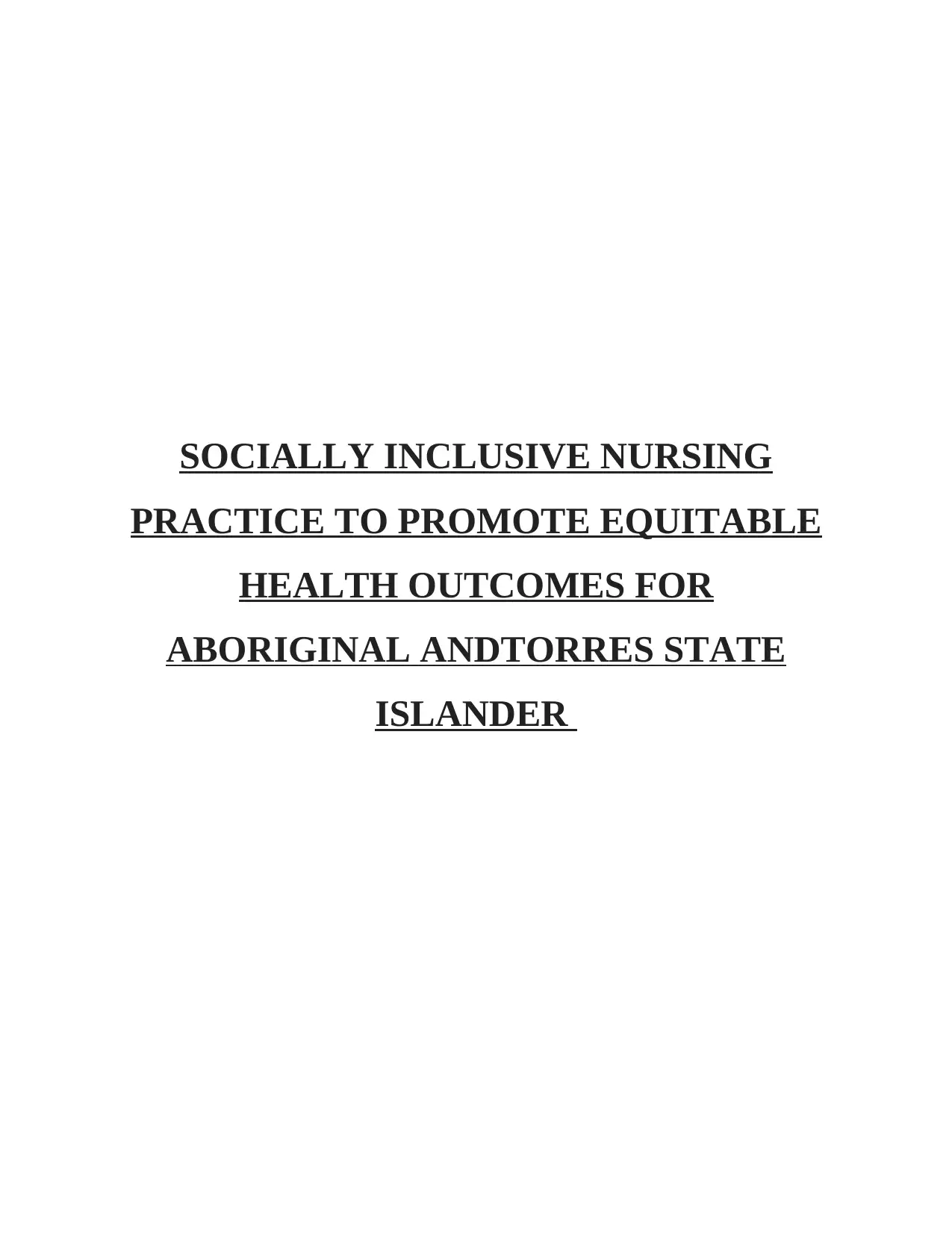
SOCIALLY INCLUSIVE NURSING
PRACTICE TO PROMOTE EQUITABLE
HEALTH OUTCOMES FOR
ABORIGINAL ANDTORRES STATE
ISLANDER
PRACTICE TO PROMOTE EQUITABLE
HEALTH OUTCOMES FOR
ABORIGINAL ANDTORRES STATE
ISLANDER
Paraphrase This Document
Need a fresh take? Get an instant paraphrase of this document with our AI Paraphraser
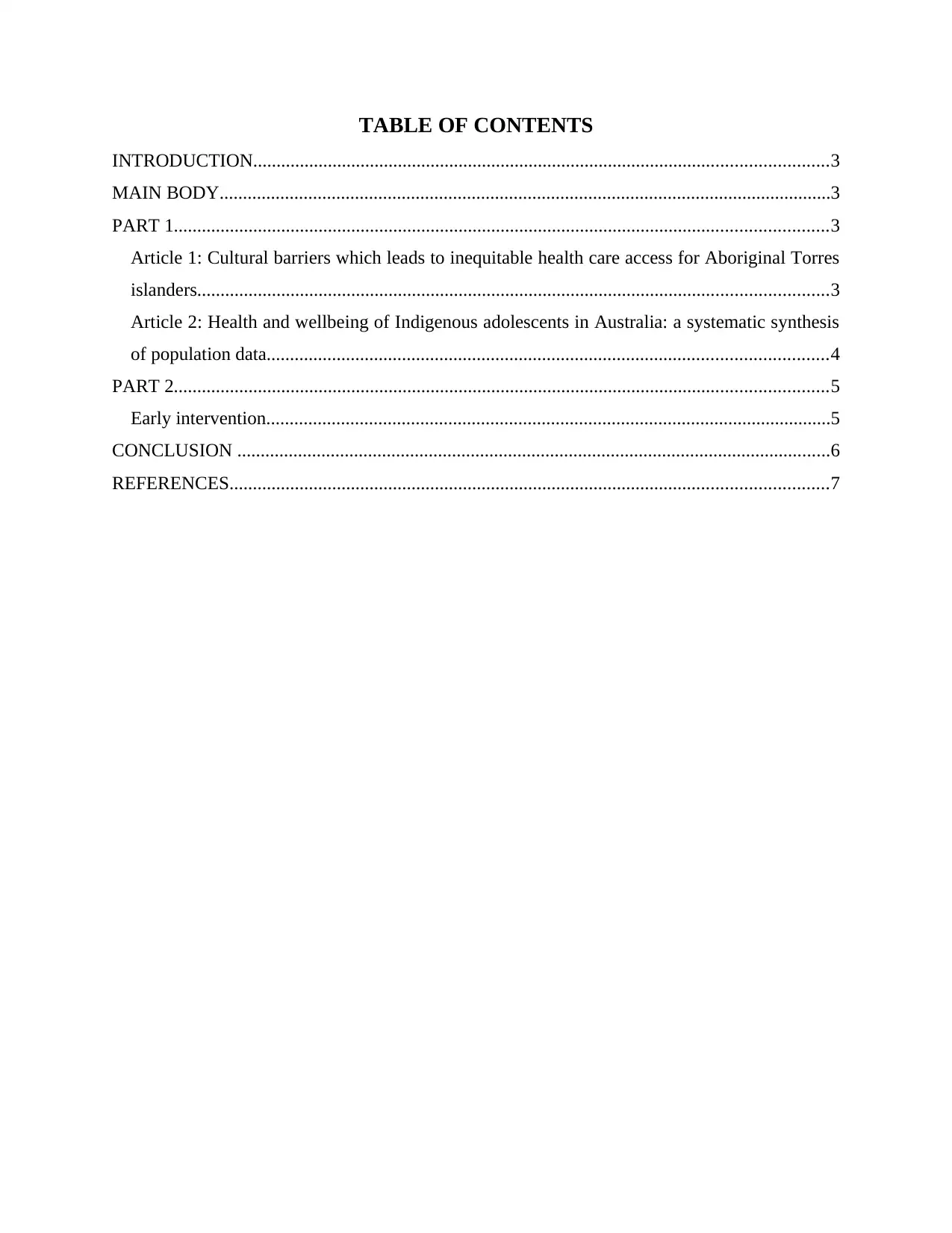
TABLE OF CONTENTS
INTRODUCTION...........................................................................................................................3
MAIN BODY...................................................................................................................................3
PART 1............................................................................................................................................3
Article 1: Cultural barriers which leads to inequitable health care access for Aboriginal Torres
islanders.......................................................................................................................................3
Article 2: Health and wellbeing of Indigenous adolescents in Australia: a systematic synthesis
of population data........................................................................................................................4
PART 2............................................................................................................................................5
Early intervention.........................................................................................................................5
CONCLUSION ...............................................................................................................................6
REFERENCES................................................................................................................................7
INTRODUCTION...........................................................................................................................3
MAIN BODY...................................................................................................................................3
PART 1............................................................................................................................................3
Article 1: Cultural barriers which leads to inequitable health care access for Aboriginal Torres
islanders.......................................................................................................................................3
Article 2: Health and wellbeing of Indigenous adolescents in Australia: a systematic synthesis
of population data........................................................................................................................4
PART 2............................................................................................................................................5
Early intervention.........................................................................................................................5
CONCLUSION ...............................................................................................................................6
REFERENCES................................................................................................................................7
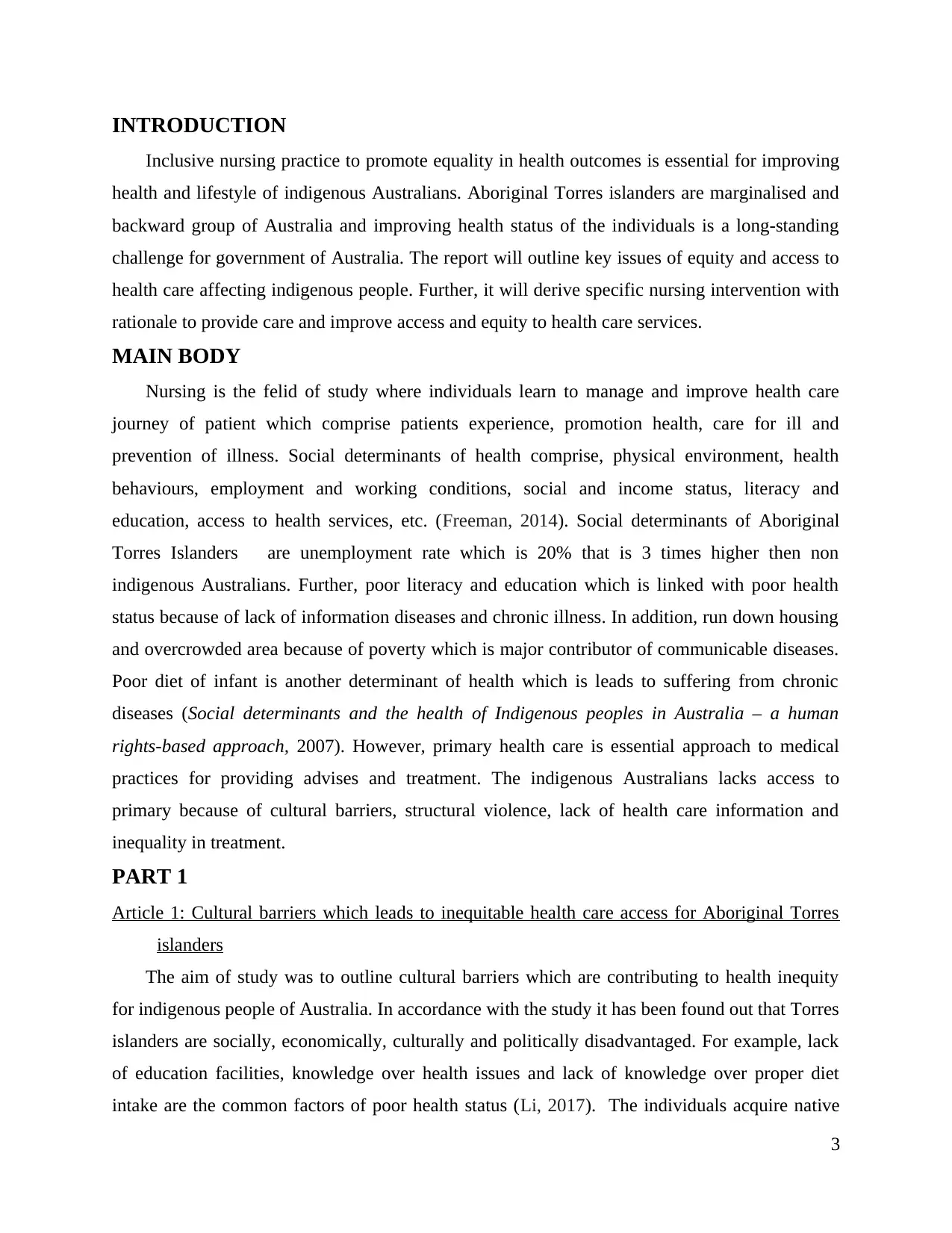
INTRODUCTION
Inclusive nursing practice to promote equality in health outcomes is essential for improving
health and lifestyle of indigenous Australians. Aboriginal Torres islanders are marginalised and
backward group of Australia and improving health status of the individuals is a long-standing
challenge for government of Australia. The report will outline key issues of equity and access to
health care affecting indigenous people. Further, it will derive specific nursing intervention with
rationale to provide care and improve access and equity to health care services.
MAIN BODY
Nursing is the felid of study where individuals learn to manage and improve health care
journey of patient which comprise patients experience, promotion health, care for ill and
prevention of illness. Social determinants of health comprise, physical environment, health
behaviours, employment and working conditions, social and income status, literacy and
education, access to health services, etc. (Freeman, 2014). Social determinants of Aboriginal
Torres Islanders are unemployment rate which is 20% that is 3 times higher then non
indigenous Australians. Further, poor literacy and education which is linked with poor health
status because of lack of information diseases and chronic illness. In addition, run down housing
and overcrowded area because of poverty which is major contributor of communicable diseases.
Poor diet of infant is another determinant of health which is leads to suffering from chronic
diseases (Social determinants and the health of Indigenous peoples in Australia – a human
rights-based approach, 2007). However, primary health care is essential approach to medical
practices for providing advises and treatment. The indigenous Australians lacks access to
primary because of cultural barriers, structural violence, lack of health care information and
inequality in treatment.
PART 1
Article 1: Cultural barriers which leads to inequitable health care access for Aboriginal Torres
islanders
The aim of study was to outline cultural barriers which are contributing to health inequity
for indigenous people of Australia. In accordance with the study it has been found out that Torres
islanders are socially, economically, culturally and politically disadvantaged. For example, lack
of education facilities, knowledge over health issues and lack of knowledge over proper diet
intake are the common factors of poor health status (Li, 2017). The individuals acquire native
3
Inclusive nursing practice to promote equality in health outcomes is essential for improving
health and lifestyle of indigenous Australians. Aboriginal Torres islanders are marginalised and
backward group of Australia and improving health status of the individuals is a long-standing
challenge for government of Australia. The report will outline key issues of equity and access to
health care affecting indigenous people. Further, it will derive specific nursing intervention with
rationale to provide care and improve access and equity to health care services.
MAIN BODY
Nursing is the felid of study where individuals learn to manage and improve health care
journey of patient which comprise patients experience, promotion health, care for ill and
prevention of illness. Social determinants of health comprise, physical environment, health
behaviours, employment and working conditions, social and income status, literacy and
education, access to health services, etc. (Freeman, 2014). Social determinants of Aboriginal
Torres Islanders are unemployment rate which is 20% that is 3 times higher then non
indigenous Australians. Further, poor literacy and education which is linked with poor health
status because of lack of information diseases and chronic illness. In addition, run down housing
and overcrowded area because of poverty which is major contributor of communicable diseases.
Poor diet of infant is another determinant of health which is leads to suffering from chronic
diseases (Social determinants and the health of Indigenous peoples in Australia – a human
rights-based approach, 2007). However, primary health care is essential approach to medical
practices for providing advises and treatment. The indigenous Australians lacks access to
primary because of cultural barriers, structural violence, lack of health care information and
inequality in treatment.
PART 1
Article 1: Cultural barriers which leads to inequitable health care access for Aboriginal Torres
islanders
The aim of study was to outline cultural barriers which are contributing to health inequity
for indigenous people of Australia. In accordance with the study it has been found out that Torres
islanders are socially, economically, culturally and politically disadvantaged. For example, lack
of education facilities, knowledge over health issues and lack of knowledge over proper diet
intake are the common factors of poor health status (Li, 2017). The individuals acquire native
3
⊘ This is a preview!⊘
Do you want full access?
Subscribe today to unlock all pages.

Trusted by 1+ million students worldwide
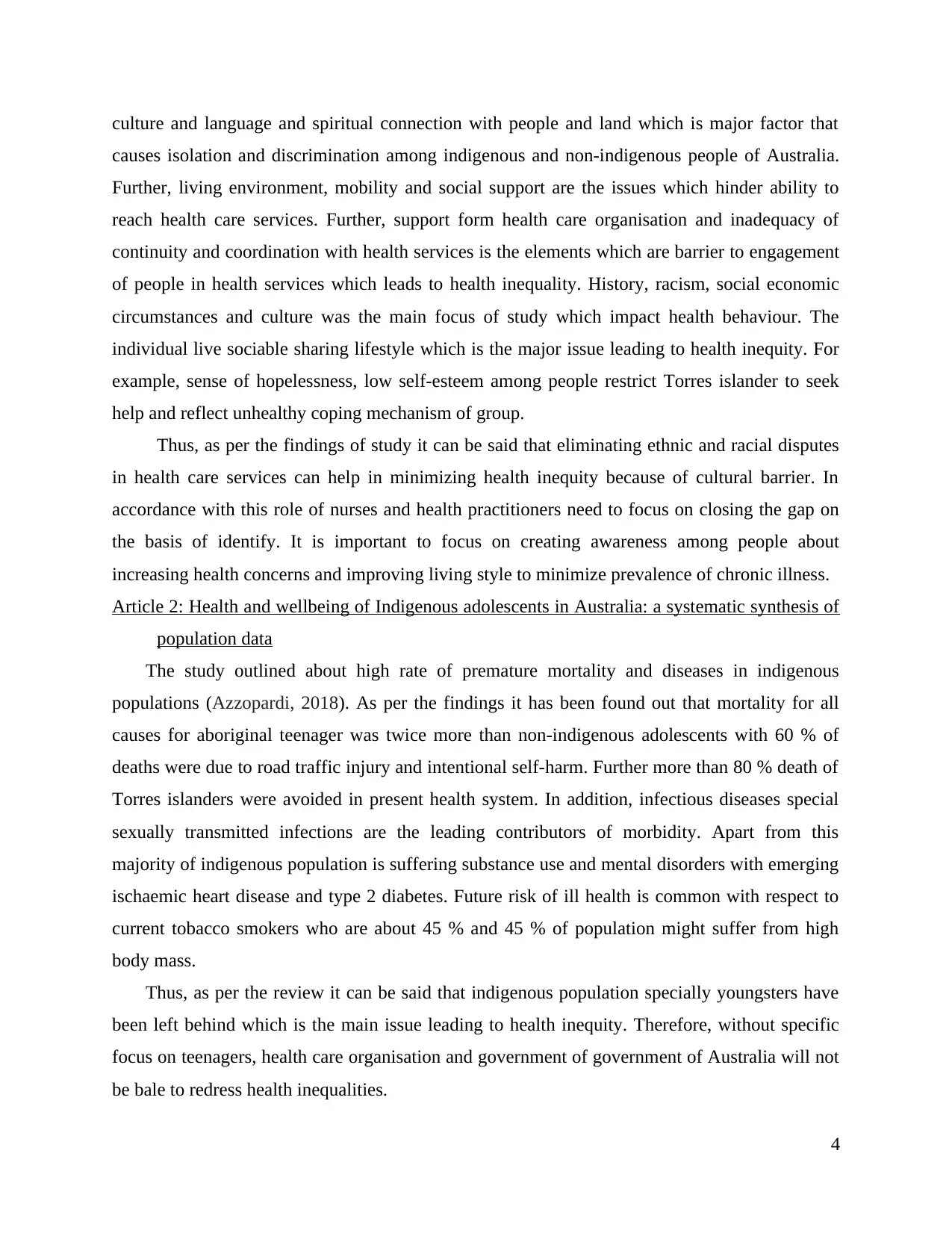
culture and language and spiritual connection with people and land which is major factor that
causes isolation and discrimination among indigenous and non-indigenous people of Australia.
Further, living environment, mobility and social support are the issues which hinder ability to
reach health care services. Further, support form health care organisation and inadequacy of
continuity and coordination with health services is the elements which are barrier to engagement
of people in health services which leads to health inequality. History, racism, social economic
circumstances and culture was the main focus of study which impact health behaviour. The
individual live sociable sharing lifestyle which is the major issue leading to health inequity. For
example, sense of hopelessness, low self-esteem among people restrict Torres islander to seek
help and reflect unhealthy coping mechanism of group.
Thus, as per the findings of study it can be said that eliminating ethnic and racial disputes
in health care services can help in minimizing health inequity because of cultural barrier. In
accordance with this role of nurses and health practitioners need to focus on closing the gap on
the basis of identify. It is important to focus on creating awareness among people about
increasing health concerns and improving living style to minimize prevalence of chronic illness.
Article 2: Health and wellbeing of Indigenous adolescents in Australia: a systematic synthesis of
population data
The study outlined about high rate of premature mortality and diseases in indigenous
populations (Azzopardi, 2018). As per the findings it has been found out that mortality for all
causes for aboriginal teenager was twice more than non-indigenous adolescents with 60 % of
deaths were due to road traffic injury and intentional self-harm. Further more than 80 % death of
Torres islanders were avoided in present health system. In addition, infectious diseases special
sexually transmitted infections are the leading contributors of morbidity. Apart from this
majority of indigenous population is suffering substance use and mental disorders with emerging
ischaemic heart disease and type 2 diabetes. Future risk of ill health is common with respect to
current tobacco smokers who are about 45 % and 45 % of population might suffer from high
body mass.
Thus, as per the review it can be said that indigenous population specially youngsters have
been left behind which is the main issue leading to health inequity. Therefore, without specific
focus on teenagers, health care organisation and government of government of Australia will not
be bale to redress health inequalities.
4
causes isolation and discrimination among indigenous and non-indigenous people of Australia.
Further, living environment, mobility and social support are the issues which hinder ability to
reach health care services. Further, support form health care organisation and inadequacy of
continuity and coordination with health services is the elements which are barrier to engagement
of people in health services which leads to health inequality. History, racism, social economic
circumstances and culture was the main focus of study which impact health behaviour. The
individual live sociable sharing lifestyle which is the major issue leading to health inequity. For
example, sense of hopelessness, low self-esteem among people restrict Torres islander to seek
help and reflect unhealthy coping mechanism of group.
Thus, as per the findings of study it can be said that eliminating ethnic and racial disputes
in health care services can help in minimizing health inequity because of cultural barrier. In
accordance with this role of nurses and health practitioners need to focus on closing the gap on
the basis of identify. It is important to focus on creating awareness among people about
increasing health concerns and improving living style to minimize prevalence of chronic illness.
Article 2: Health and wellbeing of Indigenous adolescents in Australia: a systematic synthesis of
population data
The study outlined about high rate of premature mortality and diseases in indigenous
populations (Azzopardi, 2018). As per the findings it has been found out that mortality for all
causes for aboriginal teenager was twice more than non-indigenous adolescents with 60 % of
deaths were due to road traffic injury and intentional self-harm. Further more than 80 % death of
Torres islanders were avoided in present health system. In addition, infectious diseases special
sexually transmitted infections are the leading contributors of morbidity. Apart from this
majority of indigenous population is suffering substance use and mental disorders with emerging
ischaemic heart disease and type 2 diabetes. Future risk of ill health is common with respect to
current tobacco smokers who are about 45 % and 45 % of population might suffer from high
body mass.
Thus, as per the review it can be said that indigenous population specially youngsters have
been left behind which is the main issue leading to health inequity. Therefore, without specific
focus on teenagers, health care organisation and government of government of Australia will not
be bale to redress health inequalities.
4
Paraphrase This Document
Need a fresh take? Get an instant paraphrase of this document with our AI Paraphraser
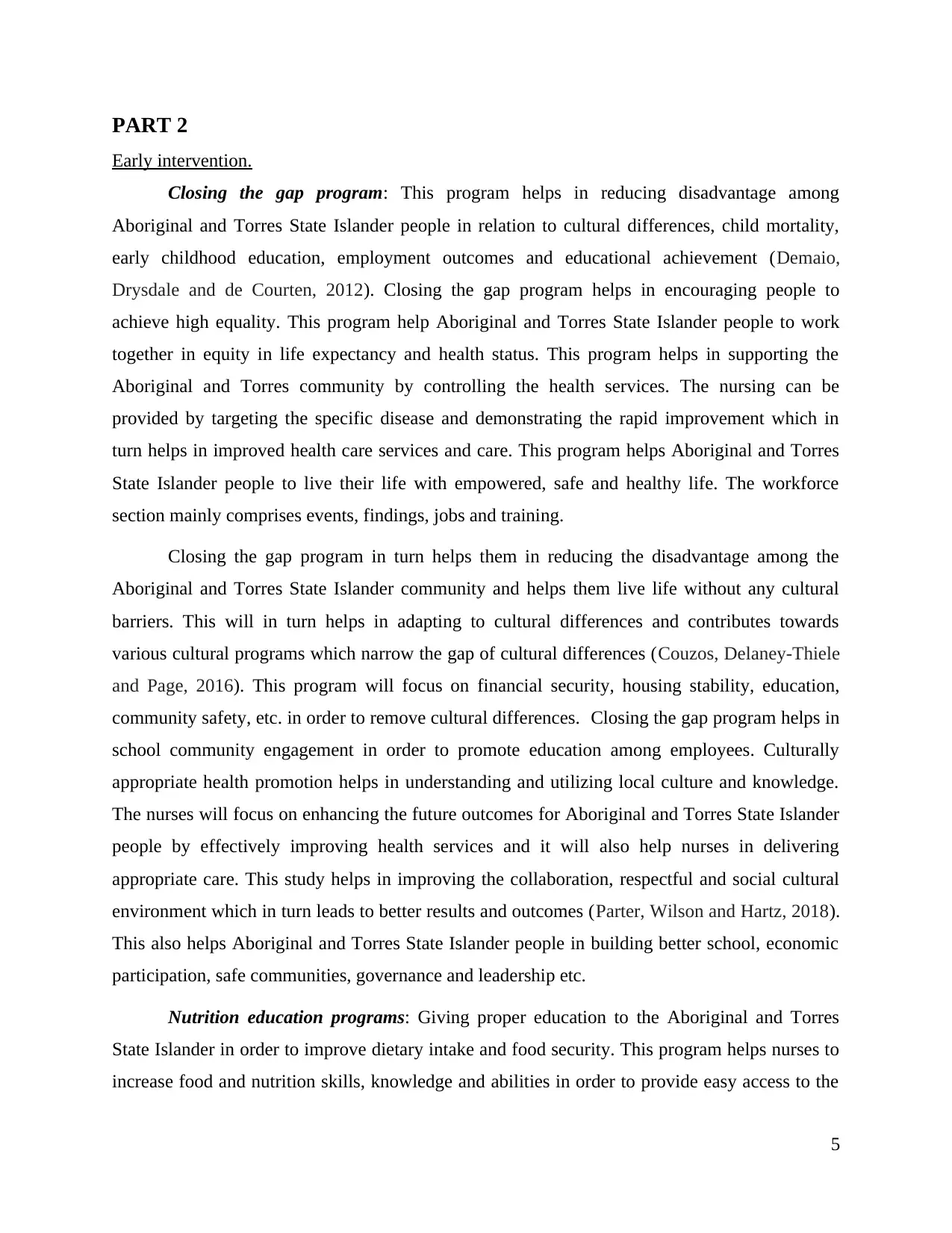
PART 2
Early intervention.
Closing the gap program: This program helps in reducing disadvantage among
Aboriginal and Torres State Islander people in relation to cultural differences, child mortality,
early childhood education, employment outcomes and educational achievement (Demaio,
Drysdale and de Courten, 2012). Closing the gap program helps in encouraging people to
achieve high equality. This program help Aboriginal and Torres State Islander people to work
together in equity in life expectancy and health status. This program helps in supporting the
Aboriginal and Torres community by controlling the health services. The nursing can be
provided by targeting the specific disease and demonstrating the rapid improvement which in
turn helps in improved health care services and care. This program helps Aboriginal and Torres
State Islander people to live their life with empowered, safe and healthy life. The workforce
section mainly comprises events, findings, jobs and training.
Closing the gap program in turn helps them in reducing the disadvantage among the
Aboriginal and Torres State Islander community and helps them live life without any cultural
barriers. This will in turn helps in adapting to cultural differences and contributes towards
various cultural programs which narrow the gap of cultural differences (Couzos, Delaney‐Thiele
and Page, 2016). This program will focus on financial security, housing stability, education,
community safety, etc. in order to remove cultural differences. Closing the gap program helps in
school community engagement in order to promote education among employees. Culturally
appropriate health promotion helps in understanding and utilizing local culture and knowledge.
The nurses will focus on enhancing the future outcomes for Aboriginal and Torres State Islander
people by effectively improving health services and it will also help nurses in delivering
appropriate care. This study helps in improving the collaboration, respectful and social cultural
environment which in turn leads to better results and outcomes (Parter, Wilson and Hartz, 2018).
This also helps Aboriginal and Torres State Islander people in building better school, economic
participation, safe communities, governance and leadership etc.
Nutrition education programs: Giving proper education to the Aboriginal and Torres
State Islander in order to improve dietary intake and food security. This program helps nurses to
increase food and nutrition skills, knowledge and abilities in order to provide easy access to the
5
Early intervention.
Closing the gap program: This program helps in reducing disadvantage among
Aboriginal and Torres State Islander people in relation to cultural differences, child mortality,
early childhood education, employment outcomes and educational achievement (Demaio,
Drysdale and de Courten, 2012). Closing the gap program helps in encouraging people to
achieve high equality. This program help Aboriginal and Torres State Islander people to work
together in equity in life expectancy and health status. This program helps in supporting the
Aboriginal and Torres community by controlling the health services. The nursing can be
provided by targeting the specific disease and demonstrating the rapid improvement which in
turn helps in improved health care services and care. This program helps Aboriginal and Torres
State Islander people to live their life with empowered, safe and healthy life. The workforce
section mainly comprises events, findings, jobs and training.
Closing the gap program in turn helps them in reducing the disadvantage among the
Aboriginal and Torres State Islander community and helps them live life without any cultural
barriers. This will in turn helps in adapting to cultural differences and contributes towards
various cultural programs which narrow the gap of cultural differences (Couzos, Delaney‐Thiele
and Page, 2016). This program will focus on financial security, housing stability, education,
community safety, etc. in order to remove cultural differences. Closing the gap program helps in
school community engagement in order to promote education among employees. Culturally
appropriate health promotion helps in understanding and utilizing local culture and knowledge.
The nurses will focus on enhancing the future outcomes for Aboriginal and Torres State Islander
people by effectively improving health services and it will also help nurses in delivering
appropriate care. This study helps in improving the collaboration, respectful and social cultural
environment which in turn leads to better results and outcomes (Parter, Wilson and Hartz, 2018).
This also helps Aboriginal and Torres State Islander people in building better school, economic
participation, safe communities, governance and leadership etc.
Nutrition education programs: Giving proper education to the Aboriginal and Torres
State Islander in order to improve dietary intake and food security. This program helps nurses to
increase food and nutrition skills, knowledge and abilities in order to provide easy access to the
5

information (Macniven and et.al., 2017). The effective strategies like cooking programs have to
be built which helps in improving the food security and healthy care among Aboriginal and
Torres State Islander. Peer educator programs helps in educating children. This helps in
diversifying the nutritional information in order to improve health care. This in turn helps
Aboriginal and Torres State Islander to take health decisions themselves to live health life for the
long run.
In order to improve health services in Aboriginal and Torres State Islander the nursing
care should be provided by controlling the population level approach. Proper nutrition chart
should be made which helps in making people understand the nutritious factor of eating healthy
food. Nutritious food should be made available near the community which helps in easy access
to the fresh fruits and vegetables (Australian Indigenous Health, 2018). The food should be
provided for free or at highly subsidised to consume healthy food and this eventually helps in
improving health care among Aboriginal and Torres State Islander.
Income management programs helps in effectively improving the well being of
Aboriginal and Torres State Islander. Community programs helps in improving the food supply
in order to improve the supply, accessibility, affordability and acceptability of the healthy food.
Home gardens and food gardens helps Aboriginal and Torres State Islander in understanding the
importance of nutritious food and also work in the garden (Gwynn and et.al., 2019). Maternal
and child health programs will help in health promotion in relation with birth weight, nutrition
intake, feeding, etc. This leads to improved health services among individuals and also in turn
lower the mortality rate.
CONCLUSION
From the above study it has been concluded that, Cultural barriers which leads to
inequitable health care access for Aboriginal Torres islanders. It also highlights, Health and well-
being of Indigenous adolescents in Australia: a systematic synthesis of population data. It will
further include evidence based nursing intervention to provide care to Aboriginal Torres
islanders.
6
be built which helps in improving the food security and healthy care among Aboriginal and
Torres State Islander. Peer educator programs helps in educating children. This helps in
diversifying the nutritional information in order to improve health care. This in turn helps
Aboriginal and Torres State Islander to take health decisions themselves to live health life for the
long run.
In order to improve health services in Aboriginal and Torres State Islander the nursing
care should be provided by controlling the population level approach. Proper nutrition chart
should be made which helps in making people understand the nutritious factor of eating healthy
food. Nutritious food should be made available near the community which helps in easy access
to the fresh fruits and vegetables (Australian Indigenous Health, 2018). The food should be
provided for free or at highly subsidised to consume healthy food and this eventually helps in
improving health care among Aboriginal and Torres State Islander.
Income management programs helps in effectively improving the well being of
Aboriginal and Torres State Islander. Community programs helps in improving the food supply
in order to improve the supply, accessibility, affordability and acceptability of the healthy food.
Home gardens and food gardens helps Aboriginal and Torres State Islander in understanding the
importance of nutritious food and also work in the garden (Gwynn and et.al., 2019). Maternal
and child health programs will help in health promotion in relation with birth weight, nutrition
intake, feeding, etc. This leads to improved health services among individuals and also in turn
lower the mortality rate.
CONCLUSION
From the above study it has been concluded that, Cultural barriers which leads to
inequitable health care access for Aboriginal Torres islanders. It also highlights, Health and well-
being of Indigenous adolescents in Australia: a systematic synthesis of population data. It will
further include evidence based nursing intervention to provide care to Aboriginal Torres
islanders.
6
⊘ This is a preview!⊘
Do you want full access?
Subscribe today to unlock all pages.

Trusted by 1+ million students worldwide

REFERENCES
Books and Journals
Azzopardi, P. S., Sawyer, S. M., Carlin, J. B., Degenhardt, L., Brown, N., Brown, A. D., &
Patton, G. C. (2018). Health and wellbeing of Indigenous adolescents in Australia: a
systematic synthesis of population data. The Lancet, 391(10122), 766-782.
Couzos, S., Delaney‐Thiele, D. and Page, P., 2016. Primary health networks and aboriginal and
torres strait islander health. Medical Journal of Australia. 204(6). pp.234-237.
Demaio, A., Drysdale, M. and de Courten, M., 2012. Appropriate health promotion for
Australian Aboriginal and Torres Strait Islander communities: crucial for closing the
gap. Global Health Promotion.19(2). pp.58-62.
Freeman, T., Edwards, T., Baum, F., Lawless, A., Jolley, G., Javanparast, S., & Francis, T.
(2014). Cultural respect strategies in Australian Aboriginal primary health care services:
beyond education and training of practitioners. Australian and New Zealand Journal of
Public Health. 38(4). 355-361.
Gwynn, J and et.al., 2019. Effect of nutrition interventions on diet-related and health outcomes
of Aboriginal and Torres Strait Islander Australians: a systematic review. BMJ open.9(4).
p.e025291.
Li, J. L. (2017). Cultural barriers lead to inequitable healthcare access for aboriginal Australians
and Torres Strait Islanders. Chinese Nursing Research, 4(4), 207-210.
Macniven, R and et.al., 2017. A snapshot of physical activity programs targeting Aboriginal and
Torres Strait Islander people in Australia. Health Promotion Journal of Australia. 28(3).
pp.185-206.
Parter, C., Wilson, S. and Hartz, D.L., 2018. The Closing the Gap (CTG) Refresh: Should
Aboriginal and Torres Strait Islander culture be incorporated in the CTG framework?
How?. Australian and New Zealand journal of public health.
Online
Australian Indigenous Health. 2018. [ONLINE]. Available
through:<https://pdfs.semanticscholar.org/35b8/5fd1a7fce053cc1f5d2f5f0cf5d322193eb1.
pdf>
7
Books and Journals
Azzopardi, P. S., Sawyer, S. M., Carlin, J. B., Degenhardt, L., Brown, N., Brown, A. D., &
Patton, G. C. (2018). Health and wellbeing of Indigenous adolescents in Australia: a
systematic synthesis of population data. The Lancet, 391(10122), 766-782.
Couzos, S., Delaney‐Thiele, D. and Page, P., 2016. Primary health networks and aboriginal and
torres strait islander health. Medical Journal of Australia. 204(6). pp.234-237.
Demaio, A., Drysdale, M. and de Courten, M., 2012. Appropriate health promotion for
Australian Aboriginal and Torres Strait Islander communities: crucial for closing the
gap. Global Health Promotion.19(2). pp.58-62.
Freeman, T., Edwards, T., Baum, F., Lawless, A., Jolley, G., Javanparast, S., & Francis, T.
(2014). Cultural respect strategies in Australian Aboriginal primary health care services:
beyond education and training of practitioners. Australian and New Zealand Journal of
Public Health. 38(4). 355-361.
Gwynn, J and et.al., 2019. Effect of nutrition interventions on diet-related and health outcomes
of Aboriginal and Torres Strait Islander Australians: a systematic review. BMJ open.9(4).
p.e025291.
Li, J. L. (2017). Cultural barriers lead to inequitable healthcare access for aboriginal Australians
and Torres Strait Islanders. Chinese Nursing Research, 4(4), 207-210.
Macniven, R and et.al., 2017. A snapshot of physical activity programs targeting Aboriginal and
Torres Strait Islander people in Australia. Health Promotion Journal of Australia. 28(3).
pp.185-206.
Parter, C., Wilson, S. and Hartz, D.L., 2018. The Closing the Gap (CTG) Refresh: Should
Aboriginal and Torres Strait Islander culture be incorporated in the CTG framework?
How?. Australian and New Zealand journal of public health.
Online
Australian Indigenous Health. 2018. [ONLINE]. Available
through:<https://pdfs.semanticscholar.org/35b8/5fd1a7fce053cc1f5d2f5f0cf5d322193eb1.
pdf>
7
Paraphrase This Document
Need a fresh take? Get an instant paraphrase of this document with our AI Paraphraser

Social determinants and the health of Indigenous peoples in Australia – a human rights-based
approach. (2007). [Online]. Available through: <
https://www.humanrights.gov.au/about/news/speeches/social-determinants-and-health-
indigenous-peoples-australia-human-rights-based >.
8
approach. (2007). [Online]. Available through: <
https://www.humanrights.gov.au/about/news/speeches/social-determinants-and-health-
indigenous-peoples-australia-human-rights-based >.
8

9
⊘ This is a preview!⊘
Do you want full access?
Subscribe today to unlock all pages.

Trusted by 1+ million students worldwide

10
Paraphrase This Document
Need a fresh take? Get an instant paraphrase of this document with our AI Paraphraser

11
1 out of 11
Related Documents
Your All-in-One AI-Powered Toolkit for Academic Success.
+13062052269
info@desklib.com
Available 24*7 on WhatsApp / Email
![[object Object]](/_next/static/media/star-bottom.7253800d.svg)
Unlock your academic potential
Copyright © 2020–2025 A2Z Services. All Rights Reserved. Developed and managed by ZUCOL.





